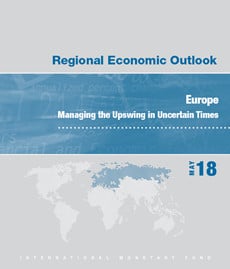Executive Summary
Europe continues to enjoy strong growth. Activity has firmed up in many economies, and the forecast is for more of the same. Real GDP increased by 2.8 percent in 2017, up from 1.8 percent in 2016. The expansion is largely driven by domestic demand. Credit growth has finally picked up, which is helping Europe’s banks rebuild profitability. While leading indicators have recently begun to ease, they remain at high levels. Accordingly, the forecast is for growth to stay strong, reaching 2.6 percent in 2018 and declining to 2.2 percent in 2019. Amid the good times, however, fiscal adjustment and structural reform efforts are flagging.
Inflation and wage growth remain subdued in most advanced economies and are projected to gather pace only very gradually, given slack in labor markets. In central and eastern Europe, by contrast, where economies are cyclically much further ahead, wages are growing rapidly and inflation is expected to pick up appreciably in 2018, potentially affecting competitiveness. As Chapter 2 discusses, the subdued wage dynamics in many advanced economies reflect low inflation and inflation expectations, still-high unemployment and underemployment rates, as well as sluggish productivity growth. In addition, there are signs that wage Phillips curves are very flat in advanced economies and that spillovers from regional labor market conditions and slow wage growth in some economies are contributing to wage moderation, holding back demand in other economies. It could thus take some time before wage growth picks up noticeably and broadly in the advanced economies.
The favorable outlook is subject to several risks that are mainly to the downside over the medium term. The most immediate risks stem from rich valuations in financial markets at the global level, notably an exceptionally low term premium and a growing tendency toward inward-looking economic policies. European markets have weathered the recent financial turbulence well, with capital flows to emerging market economies staying strong. But, as is discussed in Chapter 1, sustained large declines in stock prices are often harbingers of lower growth and inflation. With many policy rates close to the zero lower bound and central banks still engaged in unorthodox policies, the scope for further, effective policy easing in response to new shocks is not large. It is therefore all the more important to rebuild room for fiscal policy maneuver.
An important question is how long this recovery can run even in the absence of external shocks. On the one hand, estimates for output gaps point to little slack in most economies. On the other hand, unemployment rates—especially when defined broadly—still appear high, particularly in key advanced economies. Whether the recovery has the legs to last depends on the response of investment. Chapter 1 shows that investment has generally been subdued, and mainly for replacement purposes. It has also been much weaker than after the global crisis of 1991.
With economic prospects continuing to improve in the short term but medium-term prospects less bright, policymakers should seize the moment to rebuild room for fiscal maneuver and push forward with reforms to boost growth potential. In countries where inflation is still subdued, monetary policy should continue to be supportive to ensure a durable increase in inflation to targets. In countries where inflation is hitting targets, it should gradually normalize. In many economies, policymakers should strive to bring fiscal deficits within range of balance over the next few years. This way, automatic stabilizers and fiscal stimulus can be deployed again, should downside risks materialize. Also, stabilizing and bringing down public debt would help economies better cope with the pressures from growing expenditures on pensions and health care. The combination of fiscal adjustment and easy monetary policy should also help the many economies that have rebuilt much-needed competitiveness since the crisis continue to lower their still-high net external liability positions. Fiscal adjustment should be driven first and foremost by efforts to improve the efficiency of government. This is a major challenge, particularly in many of the emerging economies in Europe that also need to work further on improving institutions and governance. Countries with ample fiscal space can and should use it to promote higher potential growth.
Finally, the recovery provides an opportunity to move faster to deepen the Economic and Monetary Union. First, more actions are needed to complete the Banking Union. Instituting a European Stability Mechanism to backstop the Single Resolution Fund would mark an important first step toward greater risk sharing. Second, there is a strong case for a central fiscal capacity, but access should be strictly conditional on compliance with the fiscal rules combined with mechanisms to prevent permanent transfers between countries. Third, with the United Kingdom leaving the single market, there is a more urgent need to advance the Capital Markets Union, which requires steps to promote harmonization of insolvency regimes and better protection of cross-border investor rights.



